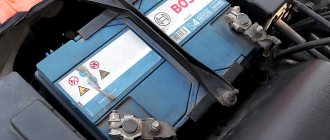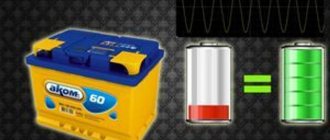17.05.2019
| (No votes) |
Issues discussed in the material:
- How does a car battery work?
- How long does it take to charge a battery at constant current?
- How long does it take to charge a car battery at constant voltage?
- What are the safety rules when charging a battery?
Before use, each battery must be carefully prepared, otherwise you risk encountering a variety of troubles. This device contains dangerous chemicals inside that can harm your car. It is for this reason that it is important to know how long to charge your car battery.
How does a car battery work?
In winter, owners are faced with the acute issue of charging their car’s battery, because starting in the cold can instantly discharge the battery. Often, old batteries are simply handed over to buyers and new ones are purchased, but there are also vehicle owners who recharge them for further use. Modern car batteries can last you up to 5 years, but this is only if you use them correctly. Otherwise, for example, if the current is supplied incorrectly or the charging time is incorrect, the battery will quickly fail.
To correctly approach charging a car battery, you first need to understand the special terms. For example, capacity is measured in ampere-hours, that is, if you see the inscription 60 A on your battery, therefore, it delivers exactly this amount of charge per hour. In addition, if the load drops to 30 A, it already takes two hours to release a charge of 60 A, etc. It turns out that depending on how many amperes are at the output, it takes a different amount of time to charge the car battery at a certain speed. If you don't take this point into account, you'll be in trouble.
It so happens that the normal voltage of a car battery is considered to be 12 volts, however, this is not entirely true. This value is average. Typically, a working battery has a charge of 12.6–12.7 V. This is a fully charged car battery.
We recommend
“Normal car battery voltage: numbers you need to memorize” Read more
At 12 V, the battery charge will be approximately 50%. It's quite possible to travel with it. After all, with a fully functioning system in your car, the charge will quickly reach 100%. Separately, it must be emphasized that a charge indicator of 11.5–11.6 V indicates the so-called “deep charging”. This has an extremely adverse effect on the car battery: a process of “sulfation” of the internal lead plates occurs, which significantly reduces the battery capacity. In some cases, the car simply may not start.
Therefore, to function properly and deliver 60 amps per hour, your car battery needs to have a charge of 12.7 V. After use, it will drop to 11.6 V and will need to be recharged. And so the process repeats in a circle.
Rechargeable batteries come in two types.
- The first is maintenance-free batteries. A special electrolyte is sealed inside them, which in any case cannot evaporate. And if this happens, then it turns into steam and condenses again in the same place. With this type of car batteries you will not have any problems.
- The second type is rapidly becoming a thing of the past, because it requires special maintenance. Such batteries do not have a strictly sealed case, and the liquid from them can evaporate freely. This type of battery is considered very problematic; it requires some care and constant recharging.
What needs to be done to charge the second type battery? First, remove all condensation and dirt from the surface. To do this, you will need a rag and a solution of regular soda. Wipe the entire top of the battery with this product. Pay close attention to cleaning the contacts, because if your battery has a screw-on cover, when it slides, all the external dirt will immediately get inside, which is harmful to the operation of the battery.
After unscrewing the cap, check the electrolyte level. If it does not cover the plates, then you need to add distilled water. It will prevent heating of the lead plates and rapid wear of the car battery.
In addition, measure the density of the electrolyte. Ideally, for a fully working battery it is 1.26–1.30 g/cm3.
Why does a car battery drain?
Before we understand how long it takes to charge a battery, first let’s figure out why a car battery is discharged. When the driver turns on the ignition without starting the engine, the battery begins to discharge. When the engine starts, the generator begins to function and feeds the car’s battery. In this case, the generator charges the car battery almost completely; this process is carried out over several years (usually up to five). Subsequently, the battery life begins to deplete.
It should be noted that the battery itself always discharges, but not critically. If the battery is charged, the vehicle can sit without starting the engine for about ten months, after which the engine will be able to start normally. But if the car battery is already worn out enough, then it can last about a month and this will be the maximum when it will be possible to start the engine. If the car's battery is not able to withstand two days of idle time, then its further use will no longer be practical, since starting the internal combustion engine will only be possible after recharging.
Charging a car battery
It should also be noted that the battery shrinks significantly at sub-zero temperatures. In cold weather, the self-discharge current will increase greatly, and accordingly, the charge itself will quickly decrease. Every car owner should know one thing. If the car battery is discharged in the cold, then before you start charging, it is imperative to warm it up. Only after the device is at room temperature should you connect the device to charge at 55 or 60 Ah.
Other less common reasons include:
- Bad anti-theft system. Since the anti-theft system always functions after the driver turns it on, a small discharge still occurs. Especially if the system is satellite, it is quite possible that the battery will discharge quickly. Of course, abandoning the anti-theft system is not an option, because the safety of the vehicle depends on it. However, remember that when installing a new alarm system “stuffed” with various functions, you should think through a certain battery charging system in advance.
- Acoustics. Of course, having a new multimedia system in a car with a subwoofer and various amplifiers is good, no one will argue. But it is necessary to take into account that all additional devices are current consumers, so you should not be surprised at the rapid discharge. Especially when it comes to low-quality and non-original systems
- Incorrect operation of electrical components. If spark distributors, various units, a starter or a high-voltage coil are not working properly in a car, this may well lead to accelerated battery discharge. Since all these elements are directly connected to each other, the failure of one of them will sooner or later affect the others. Therefore, if you notice a problem in the operation of electrical components, you need to solve it as quickly as possible.
- Problems with the generator. One of the most basic components of any vehicle electrical system is the alternator. And its incorrect operation may be the reason that the battery discharges much faster than expected. As a rule, the cause of the breakdown is the failure of the voltage regulator fuse in the car circuit. In this case, solving the problem is not so difficult - you just need to purchase and install a new generator, but the cost of solving the issue can be very high. It is much more difficult to determine whether a generator is faulty, because in some cases even a new generator can work for a week and fail. In addition, the cause of this problem can also be a weakly tensioned alternator belt, because in this case the device will also not be able to operate at full power (video author - TheLadaGranta).
How long does it take to charge a car battery at constant current?
To charge the battery using DC current, go through several steps step by step. This information will also be relevant to you if you want to know how much to charge a car battery at 60 amperes per hour. Use chargers that can be adjusted manually and keep the entire process under personal control. Calculate the supplied current correctly. It should be no more than one tenth of the calculated battery capacity. For example, if your unit has a rated capacity of 55 A, then it must be serviced at a current of 5.5 A. If these requirements are met, charging will take 9-10 hours. If the current decreases, the time for full charging increases accordingly. And vice versa.
- First stage of charging.
Chargers allow you to set the required current. Remember that the battery must be charged until the voltage reaches the design level of 14.4 volts. It is advisable to use a tester for control.
- Second phase.
After reaching 14.4V, reduce the current value from 5.5 to 2.75 or from 6 to 3, depending on the type of your car battery. Remember to check the voltage every 2 hours.
- The final stage.
The battery receiving a 15 volt charge is a sign for the next reduction in the current value. Let's give an example. If your battery has a capacity of 55 ampere-hour, set the value to 1.375 A. To calculate this indicator for your device, use the formula: AC capacity * 10% / 4. Continue charging and monitor the process every 2 hours. When the multimeter stops recording an increase in voltage, you can stop charging.
The time to fully charge the battery is an individual indicator. It may depend not only on the type of car battery, but also on its ability to accept a charge. There are batteries that need more than a day to fully charge. The only thing worth saying is: the newer the unit, the more time it takes to fully recover. So, a new car battery needs approximately 1–2 days to charge, while an already used battery will require about 12–16 hours.
Battery charging time
Any specialist will tell you that fast charging for 15-20 minutes is always healthier for a car battery than passing hundreds of amperes through the device. It is also necessary to take into account that the device needs a high-quality voltage source, so it is advisable that the outlet be approximately 4 kW. This figure is average, taking into account the efficiency of the charger and the not particularly high current strength. In fact, this figure can be much higher, especially if we are talking about a high-quality charger with 55 or 60 Ah.
For a simple passenger car you will need about 150-300 amperes, this is approximately 2000-3600 W if the voltage is 12 volts. The efficiency of the charger will be about 0.6, as a result you will get the same 4 kW. It is necessary to take into account that not every network in the apartment can withstand such voltage - sometimes when connecting a 55 or 60 Ah charger it simply knocks out the plugs. If you don’t know how long it takes to charge the battery, then to make the right purchase, you should rely on several parameters. The main one is that the device will be a charger or a jump-charging device (the author of the video on how to properly charge a battery is Banner-akb).
If you are buying a 55 or 60 Ah starter charger, then you need to find out what starting current in your vehicle is needed to start the engine. The device is selected in accordance with this indicator; you can purchase a memory with a reserve. In such matters, it is better not to save money, but to purchase a more expensive 60 Ah device, this is especially true for car owners who often change cars. Moreover, start-charging devices last much longer than the batteries themselves.
If you do not need the start mode function, then usually buy a charger. The charging time of the unit depends on the power. As mentioned earlier, it takes 8-10 hours to charge a 60 Ah battery. You should also not allow the battery to work at its limit; buy a charger with a reserve - about 15-20 A. If you have several cars or also have, for example, a moped, then you can purchase a charger with the function of switching the voltage to 12-24 V. Some Garage “specialists” recommend charging the battery for a whole day - under no circumstances should this be done, since the battery will quickly exhaust its service life.
On average, charging time ranges from 8 to 15 hours.
In most cases, the charger needs to be powered from a regular household outlet; as for starting devices, they can be equipped with built-in batteries. It should be noted that such chargers often require manual adjustment during charging. If necessary, you can always purchase automatic chargers, which themselves adjust both the current strength and the voltage indicator. Agree, this can greatly facilitate the charging process as a whole.
By the way, not only chargers, but also conventional chargers can be equipped with an automatic function. If you follow the rules for choosing a device, then your battery will serve you for more than one year and will work out its entire service life.
To prevent the battery from being completely discharged, it is necessary to carefully monitor the operation of all electrical components in the vehicle. If you have even the slightest suspicion that the battery is not working at full capacity, then it is necessary to diagnose the device. The presence of electrolyte can be checked in all serviced batteries - if there is no water in the flasks, then you just need to add distilled water, but not to the limit. You can also check the battery for a nominal price in battery stores. If you notice that the starter starts to turn with difficulty in the morning, then it is important to prevent the battery from completely discharging and try to solve this problem as quickly as possible.
The device is recharged periodically and you can be sure that you will never encounter such a problem if you approach the issue of solving it wisely. In any case, if used for a long time in low charge mode, the battery will lose its capacity. As a result of periodic recharging, you will be able to pump up the battery, while fully using the electrolytes in the work.
How long does it take to charge a car battery at constant voltage?
Constant voltage is the basic principle of charging a car battery. The system supports it automatically. In addition, a special indicator indicates the charge level. This ensures a smooth battery charge, eliminating sudden surges.
How long does it take to charge a car battery with a constant voltage charger? Such devices are distinguished by an automatic terminal voltage regulation system. When using it, the internal resistance in the car battery drops in proportion to the decrease in current strength and the increase in capacity charge. When charged at 200 milliamps, the device turns off. This is a fully automated process, and the battery owner does not need to control the charge.
How long does it take to charge a car battery to reach 100% capacity? It will take at least a day to reach a voltage of 14.4 V. And in percentage terms, the capacitive charge will reach 80%. If you charge the battery at 15 V, then it will take a day to reach 90% charge. Therefore, for your car battery to receive a 100% charge, you need at least 24 hours at 16 V.
This is a very simple method, and therefore very popular. It is great for beginners who are not very knowledgeable about the structure of a car, as it requires minimal training.
How to prepare the battery for charging
Wherever the car battery is charged, the main thing is that the room for this is as safe as possible. When the battery begins to charge, it begins to release toxic chemical fumes. Therefore, the room should be well ventilated and ventilated. Also, you should not charge the battery where there may be problems with electrical wiring in the form of periodic power surges and power outages. Of course, any operation with a battery is carried out where there are no open sources of fire or flammable substances.
It is necessary to charge the car battery by first cleaning it from dirt and dust, and also completely discharging it before charging. Quickly discharging the battery is easily done using a load in the form of light bulbs. One or two are connected to the terminals, and then you have to wait until they go out.
Regardless of how long it takes to charge a car battery, during the entire charging process all possible holes in the battery should be left open, unscrewing the caps and plugs so that the plastic case does not swell and rupture due to the large accumulation of gases inside.
How long does it take to quickly charge a car battery?
This method is only suitable for one-time starting of the car engine. It can only be used on modern charging devices. The process itself takes 20 minutes. Strictly monitor the time, as charging for too long can lead to battery damage.
It happens that chargers do not have an accelerated mode. In this case, all control is carried out manually. Set the current to no more than 25-30% of the standard. Exceeding this figure negatively affects the life of your car's battery.
Use a multimeter (load fork) in your work. This device allows you to competently control the voltage level and determine the correct degree of charge of the car battery.
It would also be a good idea to use a hydrometer. It sets the density of the electrical composition, which affects the state of charge. The density is checked in each jar. Pay close attention to this indicator, because it determines how long to charge the battery at a constant or fixed current.
What voltage is considered normal on a car battery?
Many car enthusiasts are puzzled by the concept of “normal voltage” of a fully charged car battery. Finding out these parameters is quite simple. The battery voltage is tested only after the equipment has been charged. What voltage should be at the battery terminals? When, after charging the battery for 12 hours, the charge level is 12.5-13.2 V, this will be considered a normal value. Before the measurement process begins, one of the terminals is removed from the battery. A new, fully charged battery, which has previously been disconnected from the on-board network, will be able to hold a charge for 141 days. If the battery is connected to the car, the battery charge level in terms of charge voltage will decrease by 2 times. Even when the motor is turned off, current leaks. The degree of discharge is determined by using a multimeter.
Safety rules when charging a car battery
Remember that it is very important to strictly follow safety rules when charging your car battery.
- The process must take place in a closed and ventilated room in compliance with the required temperature conditions. Do not forget that toxic substances released during charging can harm your body.
- It is strictly forbidden to place heaters and heating devices near a car battery, since the substances released during charging can detonate when in contact with an open flame.
- The charging surface must be flat and free of dust.
- Do not move the battery while charging for a long time.
- Be sure to use gloves. Remove rings and other metal items from your hands. Contact with any metals has unpleasant consequences.
- Don't forget about the polarity of the terminals. Pay special attention to this when connecting them.
- All valves located on the battery open before connecting the charger. After all, in a sealed housing the pressure will increase quite quickly.
- Use only certified chargers. Any homemade units lead to battery failure.
In order to wisely choose a method for charging a car battery, it is worth taking into account the timing of the work, as well as the conditions for its implementation. Feel free to use automated battery charging devices. This will make the process much easier.
In conclusion, advice: in order to increase the life of the battery, it is necessary to provide it with high-quality and proper care in a timely manner. Take the time to charge and follow all technical instructions when performing this process.











